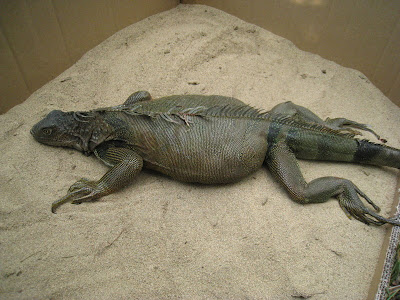Every time I thought I had a farmer who believed in the project he would say to me something like, "Why don't we try fish farming instead?" (The village had already tried Tilapia farming but had given it up after a few months because of disagreements over property.) Eventually I decided to cut my losses short because I could see that the project would fall apart when I left, if not sooner, and the time and money invested would go to waste. By a stroke of luck, a thoughtful mama iguana decided to lay her eggs in our compost pile. With the help of my friends Yoel and Sabine we built an in-ground incubator for the eggs and buried them in the sand. Unfortunately mother nature was not on our side, and the 'summer' months of March-May were miserably 'cold' and rainy and only 3 iguanitas hatched in June with only 1 surviving for a few months. We named him Toni, RIP. All in all, it was a good lesson in community development project planning; even if it's a great project idea, it won't go anywhere if no one's interested. It's more important to work with the community from the start to identify projects they're committed to.
I became very involved with the village school (grades 1-6) and tried to invent new ways of bringing information to the students and community. With the money I raised (thanks to your donations!) we bought a generator so I could show movies and presentations in the village. Weekly movie nights consisted of short documentaries on the biodiversity of Panama followed by crowd pleasers such as Scooby Doo! We also sponsored a workshop with the Panamanian Agricultural Development Ministry about organic fertilizers and soil health and put the generator to good use. Just before I left, the rest of my plan came together and we bought and installed a solar panel on the school's roof and set up a laptop inside.


My hope is that the students (and teacher) will get comfortable enough with the basics of turning on/off the computer, using a mouse, understanding how a computer works, and word processing software, that if they have the chance to continue their studies outside of the village they won't be totally lost (and behind their city counterparts).

Since school is only offered until grade 6 in the village, most of the children finish their education at age 12. If their families have the resources, they can send them to live with relatives in a city where there are public middle/high schools, but most can't afford to. This year I hope to establish a scholarship fund for students from the four communities along the Mamoni River to continue their education. It's a very small way of giving back to these communities that I called home in 2009 and the people who were so gracious to me and my family. More information to come later...Stay tuned!
One final story...As I was walking through the jungle to my hut during my last week in Panama, I ran into a villager I was friendly with on the trail. He was walking back from panning for gold in the streams and had something moving strangely in his sack. I asked him about it and he brought forth a huge pregnant female iguana he had just caught along the river and was going to sell in the village so he would have some money to buy rice. I immediately offered to buy it from him (for $10, I over paid on purpose), and a few minutes later was walking home with my backpack, a machete, and an iguana under one arm. It was one of those moments where I thought to myself, "Is this really my life?".

When I arrived home I put her down in the cage I had made a year prior for the iguanas I hoped to have and untied her toe nails that were keeping her from scratching the bejeezus out of me. She laid there lazily for a few moments, and the minute I walked away I heard a huge crash and she was gone. She managed to jump a 3 ft high sheet of slick zinc and disappeared, to hopefully lay her eggs in the reserve.




